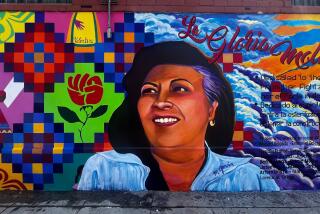Mariachi opera sings an immigrant’s tale of love and loss, in potent political times
It’s got all the usual bits: pleading duets about yearning and loss, lonely arias of memory and romance, stirring vocal harmonies. But this is not an opera written by an Italian composer to be performed at La Scala, classical strings sighing in the background. Rather, it’s a distinctly American hybrid that blends a European idiom with a musical style of Mexico.
“The moment you say ‘mariachi opera’ to anyone, they say, ‘Whoa!’” said Dan Guerrero, who is directing “Cruzar la Cara de la Luna” in Northridge this weekend. The opera, whose title translates as “To Cross the Face of the Moon,” is one of five performances this spring at the Younes and Soraya Nazarian Center for the Performing Arts that deal with the subject of immigration.
For the record:
12:05 p.m. Feb. 16, 2018The secondary photo with this article showing Daniel Rodríguez with Natalia Ferreiro and Dan Guerrero originally misidentified Ferreiro as Alba Franco-Cancél.
Set in contemporary Fort Worth and 1960s Mexico, “Cruzar la Cara” tells the tale of an elderly man looking back at a complicated life that involved leaving his native Michoacán for Texas, where he worked as a laborer. But this is no glib tale of uplift: Laurentino, played by tenor Daniel Rodríguez, had to leave his wife and son behind, and he longs for reconciliation with the family he abandoned.
“I had no way of knowing what was going to happen!” Thor Steingraber, executive director of the Soraya, said of the opera’s burning political pertinence. “But you have [House Minority Leader] Nancy Pelosi holding forth on immigration for eight hours the other day, and here we are rehearsing a piece about a migrant crossing the border.”
Indeed, when Steingraber decided to book the piece about a year ago, the centrality of the immigration debate to the nation’s conversation was still hard to read. President Trump had been in office only a few weeks. He had denounced immigrants — attributing rape and crime to migrants from Mexico — but there was so much noise in the air, it was not clear which issues would remain in the headlines.
Steingraber said he had already been working to develop a Latino audience and an emphasis on Mexican regional music because of the demographics of the San Fernando Valley and specifically of Cal State Northridge, where the Soraya is located.
But the rhetoric from the White House and the far right has amplified the matter. Performance pieces centered on the Deferred Action for Childhood Arrivals program have been staged all over the city, and all over the country.
“I don’t think, since the AIDS crisis, artists have rallied around an issue the way they have around migration and immigration,” Steingraber said.
Though the notion of a mariachi opera sounds exactly like the kind of cross-cultural, high-low fusion that would have been born in Los Angeles, “Cruzar la Cara” actually originated in Houston. And despite its ripped-from-the-headlines premise — Mexican man journeys north, pregnant wife dies trying to cross the border behind him — the opera is almost a decade old.
After the 2010 premiere at Houston Grand Opera, “Cruzar la Cara” traveled to several cities in the U.S. and Europe. The Northridge performance will mark the first new production since then. (Last month the New York Times’ Anthony Tommasini praised a New York City Opera performance of the earlier version for its “melancholic understatement,” supple music and ability to capture “the dilemma of immigration in sadly human ways.”)
Guerrero, a longtime Southland theater figure who directed a piece about Cesar Chavez’s connection to John F. Kennedy at the Kennedy Center in Washington, D.C., in 2016, jumped at the chance to rethink “Cruzar la Cara.”
He’d seen the opera in Fort Worth but felt it was time to reinvent the piece. In some cases, he had no choice: The original cast had dispersed, and the composer, Jose “Pepe” Martinez, who led the gold-standard Mariachi Vargas de Tecalitln, died two years ago, making the rights to the opera hard to sort out.
It was only thanks to a bizarre series of coincidences and good fortune that the new production came together. The composer’s son, Jose Martinez Jr., who grew up with Mariachi Vargas, serves as music director for the current piece.
The resulting production is largely told from Laurentino’s deathbed or in flashback, as he recounts his story to his wife, son and long-lost friends, in some cases appealing for forgiveness. The cast is an unusual mix of opera veterans (including celebrated mezzo-soprano Suzanna Guzmán), musical theater regulars and mariachi legends.
“It’s an intimate staging,” Guerrero said, standing in the rehearsal room with its masking-taped floor marks for actors and musicians. “It’s a love story, about love of family, love of country. But it’s also an epic setting,” given the vastness of the desert that Laurentino crosses and the enormous themes that are explored.
Guerrero tried to make the new production less linear and literal than the original, seeking out authentic Michoacan costumes while also bringing touches of magical realism.
As for the incongruity between Europe and Mexico, opera and mariachi, with the wildcard of American musical theater thrown in: It didn’t really matter, ultimately. The voices, the emotions, the themes — they’re all similar.
“So talent will out,” Guerrero said. “In the end, it’s all the same.”
♦ ♦ ♦ ♦ ♦ ♦ ♦ ♦ ♦ ♦
‘Cruzar la Cara de la Luna’
When: 8 p.m. Friday-Saturday, 3 p.m. Sunday
Where: Younes and Soraya Nazarian Center for the Performing Arts, also known as the Soraya (formerly Valley Performing Arts Center), 18111 Nordhoff St., Northridge
Tickets: $43 and up (subject to change)
Information: (818) 677-3000, ValleyPerformingArtsCenter.org
Running time: 1 hour, 30 minutes (no intermission)
See all of our latest arts news and reviews at latimes.com/arts.
MORE STORIES:
The broken souls of ‘Water by the Spoonful’
Tom Hanks and Rita Wilson in ‘Henry V’
Everything you didn’t know about LACMA’s ‘Urban Light’
How the Obama portraits buck the trend of presidential paintings
More to Read
The biggest entertainment stories
Get our big stories about Hollywood, film, television, music, arts, culture and more right in your inbox as soon as they publish.
You may occasionally receive promotional content from the Los Angeles Times.










